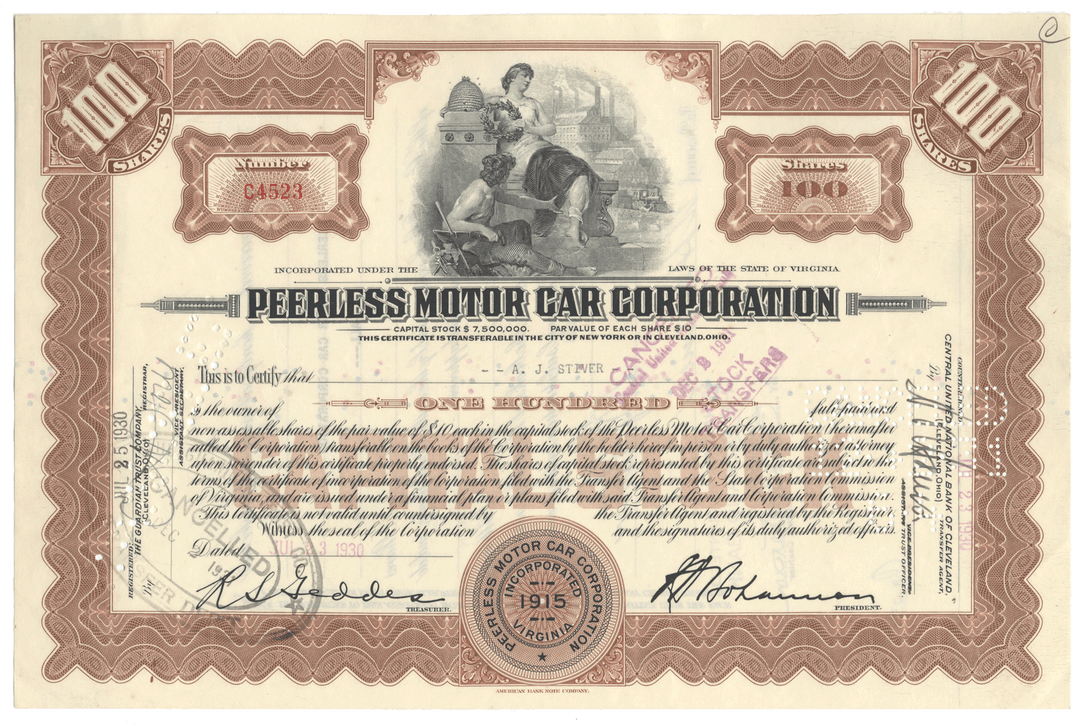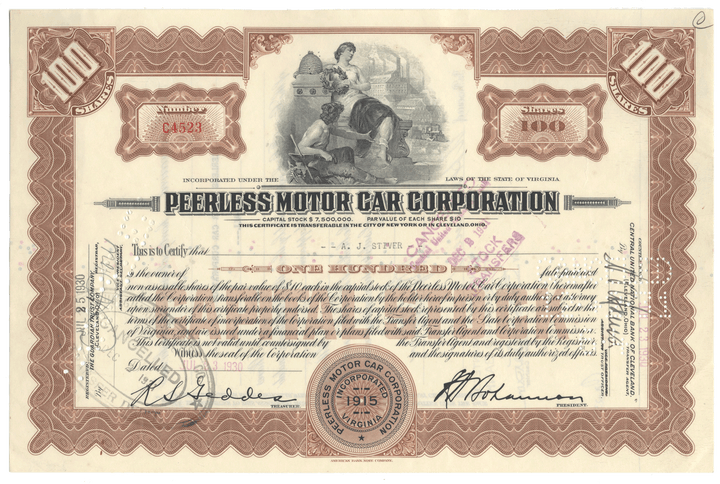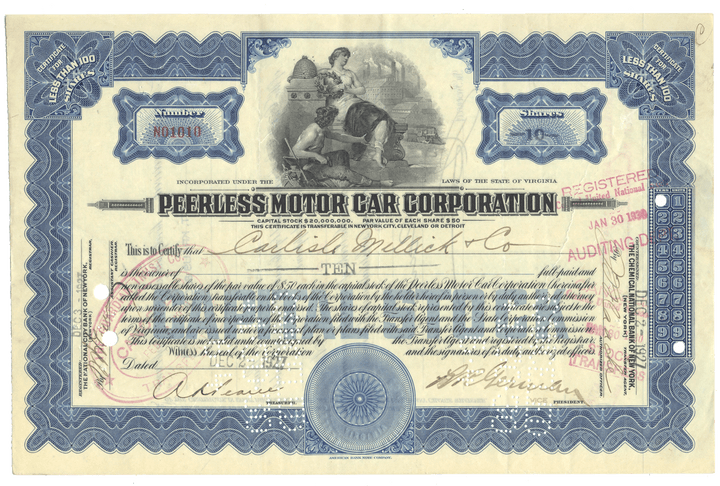Peerless Motor Car Corporation
- Guaranteed authentic document
- Orders over $75 ship FREE to U. S. addresses
Product Details
| Company | Peerless Motor Car Corporation |
| Certificate Type | Capital Stock |
| Date Issued | July 23, 1930 (brown) December 2, 1927 (blue) |
| Canceled | Yes |
| Printer | American Bank Note Company |
| Signatures | Machine printed |
| Approximate Size |
11 1/2" (w) by 7 1/2" (h) |
|
Product Images |
Show the exact certificate you will receive |
| Authentic | Yes |
| Additional Details | NA |
Historical Context

Established in Cleveland in 1900 at 43 Lisbon Street, Peerless began manufacturing automobiles while using De Dion-Bouton engines under license from the French company.
Engineer Louis P. Mooers designed the first Peerless models, as well as several proprietary engines. The first Peerless-branded vehicles appeared in 1902, with a front-mounted engine driving the rear wheels through a shaft. This later became the standard vehicle propulsion layout for automobiles. In 1904, Mooers designed the Green Dragon racecar and enlisted Barney Oldfield to drive it. The Green Dragon brought notability and success to Peerless, as Oldfield used it to set a number of early world automobile speed records.
In 1905, the 35 horsepower Green Dragon competed in the world's first 24-hour endurance race in Columbus, Ohio. Piloted by Earnest Bollinger, Aurther Feasel, and briefly by Barney Oldfield, the Peerless led the race for the first hour before crashing into a fence, later finishing in 3rd place.
From 1905 to 1907, Peerless experienced a rapid expansion in size and production volume. As the Peerless namesake grew in fame, the company began producing increasingly higher-priced models with a focus on luxury. In 1911, Peerless was one of the first car companies to introduce electric lighting on their vehicles, with electric starters added in 1913. In 1915, the firm introduced its first V8 engine, intending to compete with the Cadillac V8 introduced a year earlier. This model became Peerless' staple production vehicle until 1925, when engines produced by other manufacturers were first used in Peerless models.
During World War I, Peerless manufactured military vehicle chassis and trucks. One such vehicle, the Peerless armoured car, was manufactured for Great Britain with the Austin Motor Company of Birmingham being the maker of the armored body and Peerless the manufacture of the chassis. The chassis was manufactured in Cleveland, Ohio.
In 1929, the entire Peerless range was redesigned to compete with other vehicles produced by Stutz and Marmon. This move saw increased sales, and for 1930 another design refresh was undertaken. The Peerless-designed V8 was replaced by a Continental straight-8 as a cost-saving measure. However, the Great Depression that began in 1929 greatly reduced the sales of luxury automobiles. Peerless stripped down its production and attempted to market one line of vehicles to wealthy Americans who were not affected by the depression. In 1930–31, Peerless commissioned Murphy Body Works to design what the company envisioned as its 1933 model. The task was assigned to a young Frank Hershey, who produced a remarkably clean, elegant vehicle. A single V16-engined 1931 Peerless was finished in June 1931, the last Peerless ever produced.
Peerless remained an idle business until the end of Prohibition in 1933 allowed the manufacture of alcohol. Peerless then revamped its factory and gained a license to brew beer under the Carling Black Label and Red Cap ale brands from the Brewing Corporation of Canada.
Hershey's single prototype V-16 remained in the Peerless factory until the end of World War II and it is now owned by the Crawford Auto-Aviation Museum.
The following Peerless vehicles are deemed "classic cars" by the Classic Car Club of America (CCCA):
- 1925 Series 67
- 1926 – 1928 Series 69
- 1929 Model Eight-125
- 1930-1 Custom 8
- 1932 Deluxe Custom 8
Related Collections
Additional Information
Certificates carry no value on any of today's financial indexes and no transfer of ownership is implied. All items offered are collectible in nature only. So, you can frame them, but you can't cash them in!
All of our pieces are original - we do not sell reproductions. If you ever find out that one of our pieces is not authentic, you may return it for a full refund of the purchase price and any associated shipping charges.









